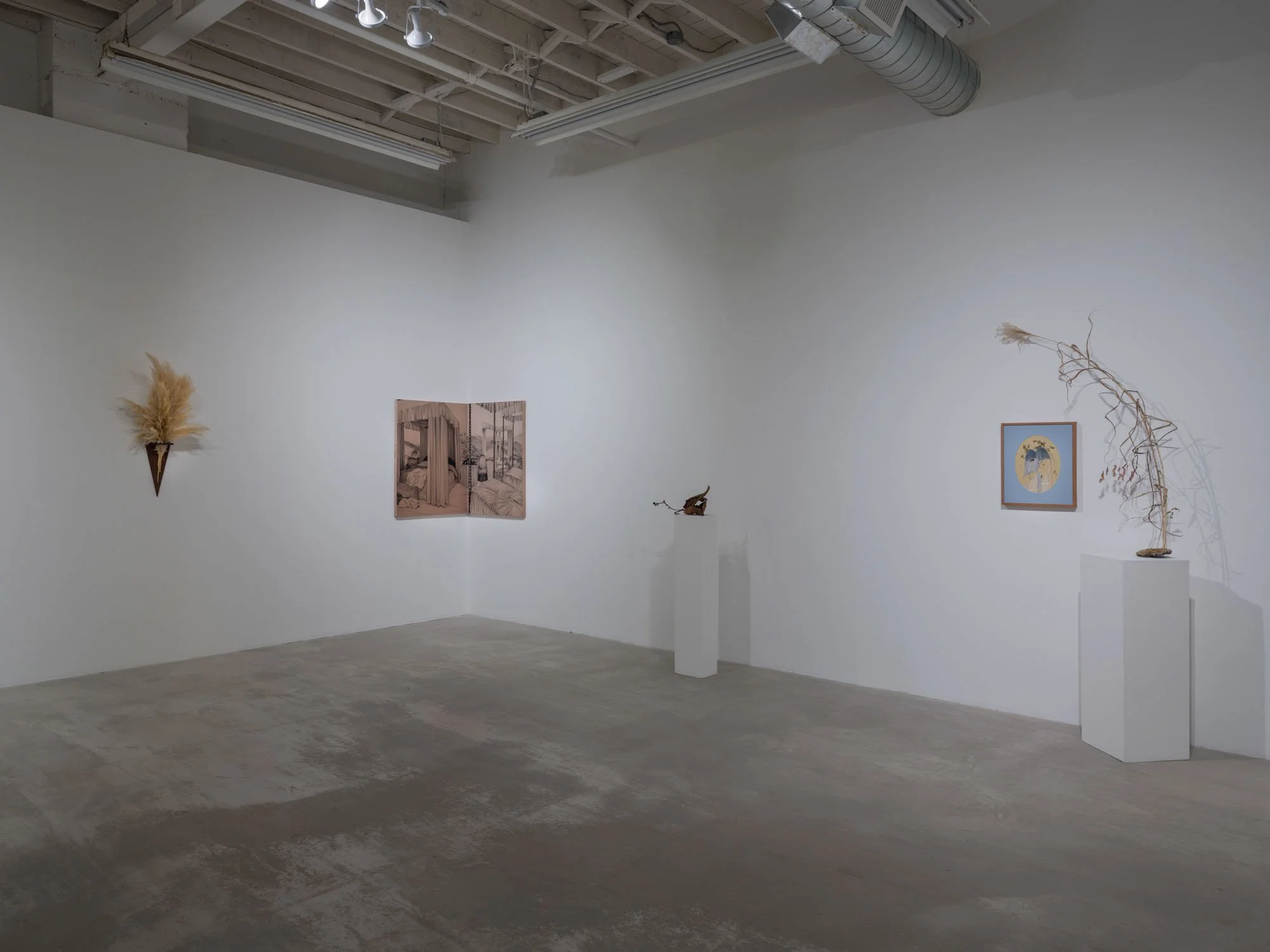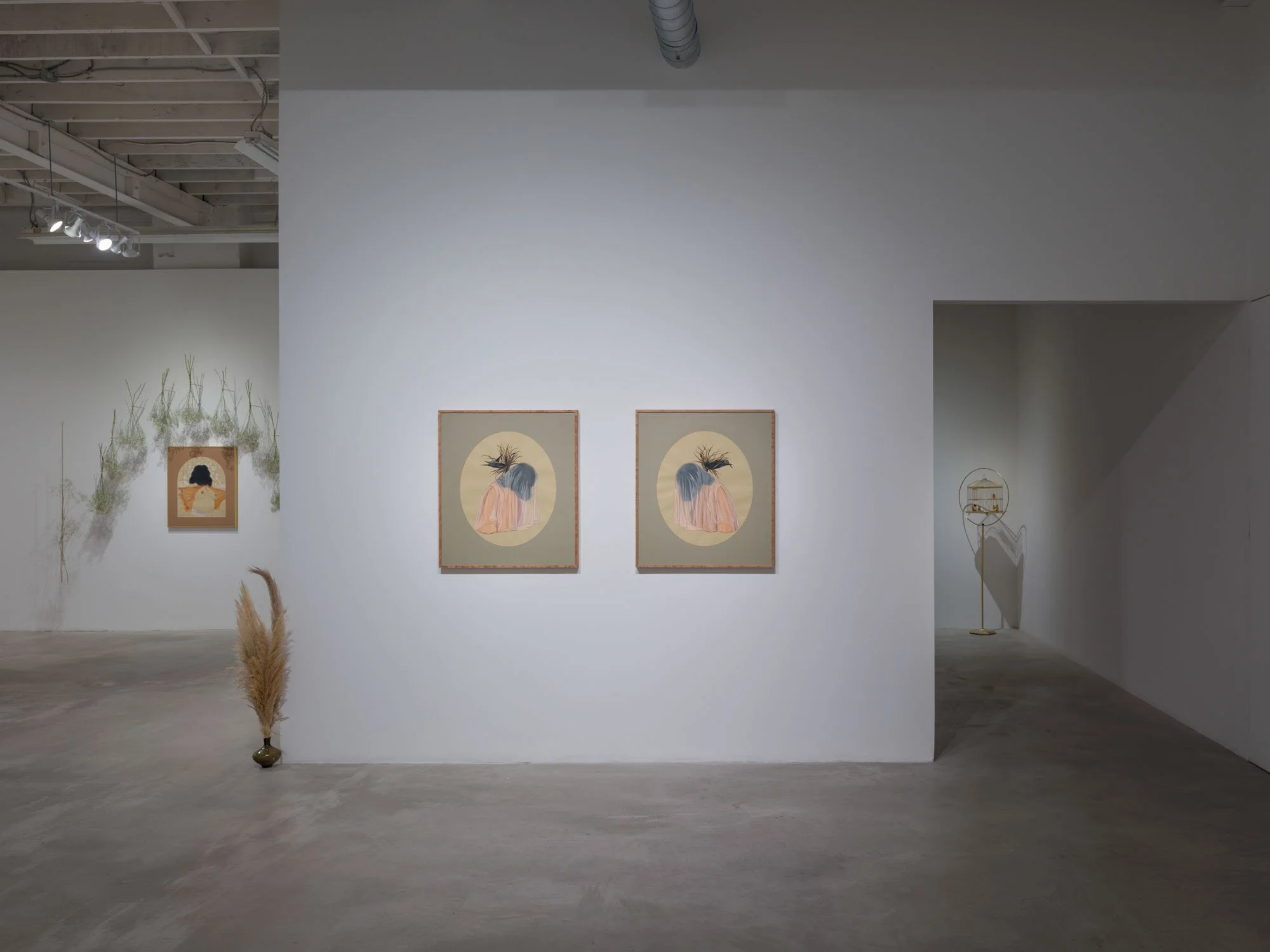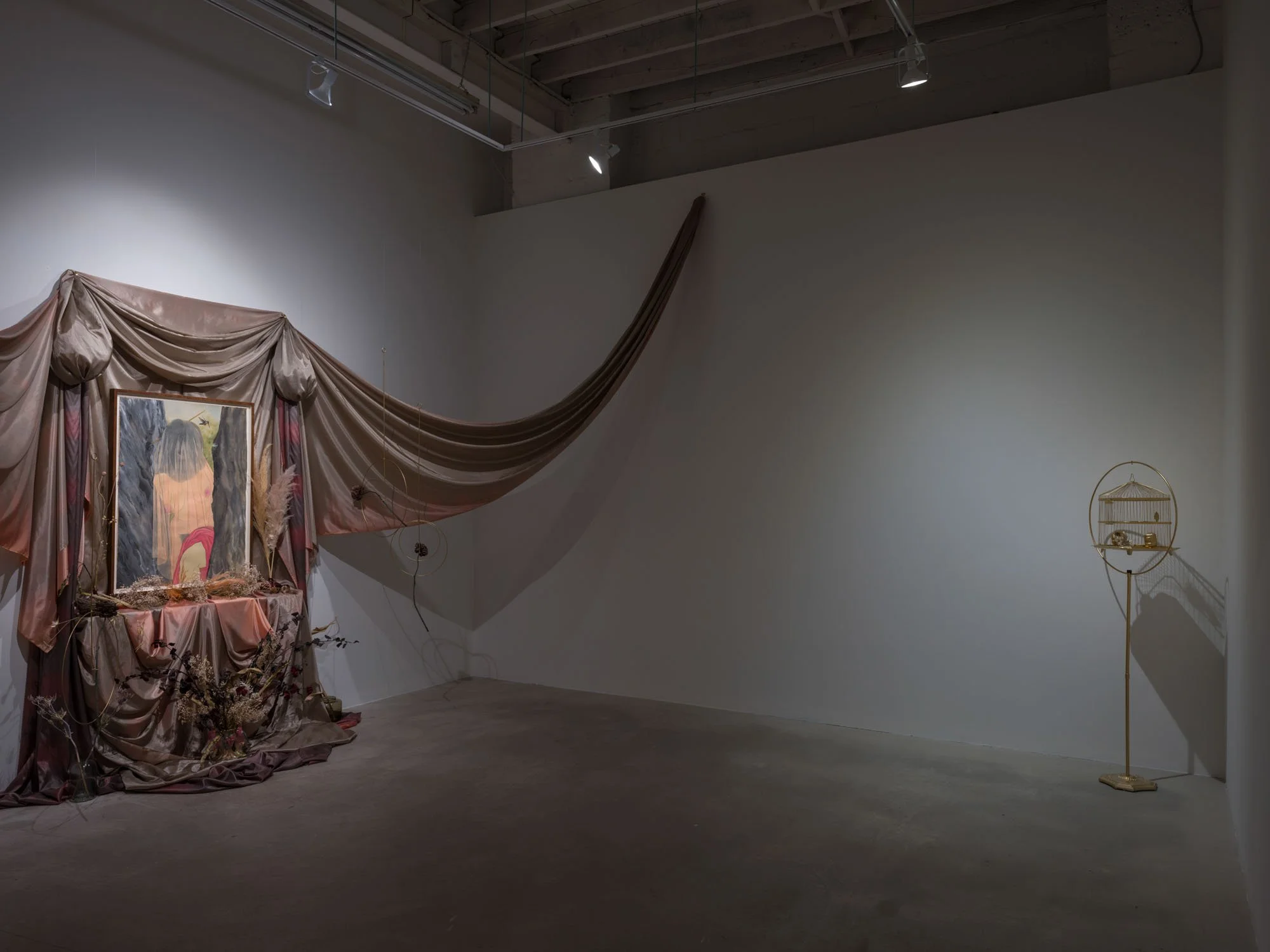21 WADE AVE #2 | TORONTO
Mia Sandhu | Mourning Glory | 13 Jan - 17 Feb 2024
It's a hazy scene: one steeped in dryness (dusty, decomposing bouquets), tactility (silk and velvet textiles), and heaviness (undeniable grief).
Mia Sandhu's third solo exhibition with Patel Brown takes on the semblance of a funerary installation akin to a vigil. Punctuated by paper-based, funerary-floral arrangements, this solemn scene is sharply contrasted by brazenly nude figures in states of mourning. Those unfamiliar with Sandhu's work might find the presence of these shrouded, nude women surprising in this reverential setting. For those acquainted with the artist's recent projects, Mourning Glory appears as another chapter in their complex realities—realities that now encompass the seemingly insurmountable challenge of processing loss. Crucial to the complexity of these topics, Sandhu also taps into the taboo subject of ambivalence, whether as a coping mechanism or actual apathy, when it comes to grief.
Mourning Glory underscores the often contradictory ways that grief can manifest: as a deep disassociated void of devastation interspersed with pockets of relief and, if we are lucky, celebration. In this vein, Sandhu gives equal importance to the "glory" aspect of Mourning Glory and posits that hope and happiness are essential to our preservation, even in the most difficult times.
With a subtle sense of optimism and humour, Mourning Glory hints at a longing for things to come, things beyond grief. Along this line of thinking, Sandhu's mourners simultaneously challenge and lean into the cinematic grieving widow trope. Although the artist didn't explicitly intend to connect to this commentary, Mourning Glory asserts there is no proper one way to grieve. With a dash of pageantry (red manicured nails and dramatized posing) coupled with the inability to see their faces or expressions, the artist dismantles a singular, prescribed way to navigate loss—grief may not manifest in bouts of emotional outpouring; it may instead be a slow burn, a profound and sluggish coming to terms.
Further toying with the archetype, Sandhu questions what is acceptable for us to grieve. Her protagonists are not mourning the loss of an individual per se. Instead, they carry the weight of other forms of loss, things we don't hold funerals for but maybe wish we could commemorate. Quietly, we grieve things that were sacrificed, absent, or never present. We grieve potential futures that never came to fruition. We grieve relationships (romantic, familial, plutonic) that never took the shape we hoped. We lament parts of ourselves that disappoint. Employing her notable cast of enigmatic protagonists, Sandhu offers a metaphorical wake for what and who has been lost and what never was.
Environments in Mourning Glory are set in and beyond the domestic. Characters venture into expansive solitary spaces: vast deserts, forests, and even oceanscapes. Notably, the artist draws inspiration from reference images captured in the Thar Desert between Pakistan and India, also known as the Great Indian Desert—a region intertwined with the artist's familial roots dating back to her grandparents. These expansive vistas evoke associations of solitude and suggest that emptiness, taking whatever shape (sand, water, snow, wind), shares a common feeling of isolation. Existing in two places at once—the indoor realm, characterized by comfort, safety, and familiarity, and the outdoors, marked by vastness—the artist marries these contrasting worlds by suggesting that grief is the great equalizer. That place, comfort, and home fall pale in the shadow of intense sorrow. It ultimately underscores that grief is experiencing both intense fullness and emptiness at the same time.
Sandhu offers a light respite from the heaviness by including hummingbirds in her compositions. An overt symbol of vitality, hummingbirds vibrate with energy and animation. Unfortunately, that respite is short-lived upon discovering that most of the birds depicted are no longer sprightly or buzzing with energy—they are lifeless. Some are even propped up by faint threads, unable to feed their young, offering only the illusion of life and sustenance. In her previous series, “A Vessel to Hold,” Sandhu investigated societal and self-imposed expectations of women and motherhood. Her characters negotiate these assumptions and demands, and they do so all the while attempting to hold onto their aspirations, sexuality and light-heartedness. In this exhibit, “We Are Both” depicts two figures mirroring one another. This drawing, with the inclusion of the expired birds, marks a continued exploration of motherhood as experienced by women, regardless of having given birth, via the expectation to be nurturers within and beyond familial ties. She suggests that the dilemma in navigating these expectations is both a burden and a gift.
Sandhu’s practice consistently confronts the intricacies of self-relationships. Tackling the concept that caregivers frequently know their loved ones more than they may have the agency or capacity to know themselves or their needs. Notably, her characters are mainly rendered through negative space. Contoured with a thin outline and sparse details, their nakedness embodies both their fortitude and susceptibility. Their strategic nudity save their faces, further reveals a complex interplay between heightened feelings of confidence and vulnerability. Beyond our physical bodies, the artist puts a spotlight on things we are the most ashamed of or what we most want to hide: a personality trait we’ve been trying to shake, a coping mechanism that we can’t seem to unlearn, or a selfishness that we aren’t prepared to shed. With this intermingling of uncertainty, poise, and exposure, Sandhu continues to tackle themes of self-acceptance, humour, safety, cultural dysphoria, and sexuality.
Despite the melancholic themes, Sandhu’s imagery opposes such overt darkness. The lightness of her imagery protects the viewers and offers a welcomed, playful tone as a reprieve. In that vein, the character’s leisurely confidence and coquettishness offer a contagious spark—an indication of renewed zeal and passion, comfort in one’s skin, and excitement for something on the horizon.
– Jenna Faye Powell
Mia Sandhu is a Punjabi Canadian artist currently residing in Toronto, Ontario. Sandhu’s multidisciplinary practice explores themes of femininity, sexuality, cultural hybridity, self authenticity, and safety. Expressed through her playful paper and gouache/watercolour based works, Sandhu seeks to examine inner conflicts seemingly intrinsic to womanhood while also challenging more abstract concepts like unrequited assimilation and cultural dysphoria. She attained her BFA from the Nova Scotia College of Art and Design in 2009 and has since participated in residencies at Cotton Factory and Smokestack Studios both located in Hamilton Ontario. Her work can be found in private collections around the world. She has exhibited across Canada, the USA and Europe.
Jenna Faye Powell is a Canadian artist, writer, and arts administrator based in Toronto, Ontario. With deep interest in intersections between art, environmentalism, and ideas that enact social change, she self-identifies as an optimist. She has attained a MFA degree from the Nova Scotia College of Art and Design University (2012), as well as a BFA degree from the University of Western Ontario (2009). Powell has exhibited nationally and internationally in various solo and group shows and currently works as the Operations Manager for Partners in Art, and Project Manager of Annandale Artist Residency.
The exhibition was made possible with the support of the Ontario Arts Council and Canada Council for the Arts.






